Boeing 707
[5] It dominated passenger air-transport in the 1960s, and remained common through the 1970s, on domestic, transcontinental, and transatlantic flights, as well as cargo and military applications.As Douglas and Lockheed dominated the postwar air transport boom, the demand for Boeing's offering, the 377 Stratocruiser, quickly faded with only 56 examples sold and no new orders as the 1940s drew to a close.The KC-97 was not ideally suited for operations with the USAF's new fleets of jet-powered fighters and bombers; this was where Boeing's new design would win military orders.Boeing studied numerous wing and engine layouts for its new transport/tanker, some of which were based on the B-47 and C-97, before settling on the 367-80 "Dash 80" quadjet prototype aircraft.In a demonstration flight over Lake Washington outside Seattle, on August 7, 1955, test pilot Tex Johnston performed a barrel roll in the 367-80 prototype.Answering customers' demands and under Douglas competition, Boeing soon realized this would not provide a viable payload, so it widened the fuselage to 144 in (3,660 mm) to allow five-abreast seating and use of the KC-135's tooling.While many 707-120Bs and -720Bs were conversions of existing JT3C-powered machines, 707-320Bs were available only as newly built aircraft, as they had a stronger structure to support a maximum takeoff weight increased by 19,000 lb (8,600 kg), along with modifications to the wing.The plane, a brand new 707-227, N7071, destined for Braniff, crash-landed on a river bed north of Seattle at Arlington, Washington, killing four of the eight occupants.[21] In his autobiography, test pilot Tex Johnston describes a Dutch roll incident he experienced as a passenger on an early commercial 707 flight.He introduced himself and relieved the ashen-faced captain who immediately left the cockpit feeling ill. Johnston disconnected the faulty autopilot and manually stabilized the plane "with two slight control movements".[25] Pratt & Whitney, in a joint venture with Seven Q Seven (SQS) and Omega Air, selected the JT8D-219 low-bypass turbofan as a replacement powerplant for Boeing 707-based aircraft, calling their modified configuration a 707RE.[26] Northrop Grumman selected the -219 to re-engine the US Air Force's fleet of 19 E-8 Joint STARS aircraft, which would allow the J-STARS more time on station due to the engine's greater fuel efficiency.However, the Comet series had been the subject of fatal accidents (due to design flaws) early in its introduction and withdrawn from service; virtually redesigned from scratch, it was still smaller and slower than the 707 when reintroduced as version -4.Anticipating this advantage, Boeing made a late and costly decision to redesign and enlarge the initial 707's wing to help increase range and payload, giving birth to the 707-320.[29] The aircraft's first commercial flight was from Idlewild Airport, New York, to Le Bourget, Paris, on October 26, 1958, with a fuel stop in Gander, Newfoundland.Its success led to rapid developments in airport terminals, runways, airline catering, baggage handling, reservations systems, and other air transport infrastructure.The advent of the 707 also led to the upgrading of air traffic control systems to prevent interference with military jet operations.[2][37] After suspending its scheduled passenger service in April 2013,[1] Saha continued to operate a small fleet of 707s on behalf of the Iranian Air Force.Powered by four Pratt & Whitney JT3C turbojets, the initial 720 could cover a 2,800 nmi (5,200 km; 3,200 mi) range with 131 passengers in two classes.It had four Pratt & Whitney JT3C-6 turbojets, civilian versions of the military J57, initially producing 13,000 lbf (57.8 kN) with water injection.The British Air Registration Board refused to give the aircraft a certificate of airworthiness, citing insufficient yaw control, excessive rudder forces, and the ability to over-rotate on takeoff, stalling the wing on the ground (a fault of the de Havilland Comet 1).Boeing responded by adding 40 in (100 cm) to the vertical stabilizer, applying full instead of partial rudder boost, and fitting an underfin to prevent over-rotation.The wing was modified from the -320 by adding a second inboard kink, a dog-toothed leading edge, and curved low-drag wingtips instead of the earlier blunt ones.These reduced takeoff and landing speeds and altered the lift distribution of the wing, allowing the ventral fin found on earlier 707s to be removed.One of the final orders was by the Iranian Government for 14 707-3J9C aircraft capable of VIP transportation, communication, and in-flight refueling tasks.After testing in 1979, N707QT, the last commercial 707 airframe, was restored to 707-320C configuration and delivered to the Moroccan Air Force as a tanker aircraft via a "civilian" order.This 412,000-pound MTOW (187,000 kg) variant was to be powered by four 22,500-pound-force thrust (100 kN) Pratt & Whitney JT3D-15 turbofan engines, and it would have had a nearly 10-foot (3.0 m) extension in wingspan, to 155.5 feet (47.4 m).The VC-137 variant of the Stratoliner was a special-purpose design meant to serve as Air Force One, the secure transport for the President of the United States.In essence the same system as used on the earlier Boeing 377, the code consisted of two digits affixed to the model number to identify the specific aircraft version.[52] The plane is planned to be flown to Shellharbour Airport, where HARS is based, once repairs to ensure safe flying condition have been completed.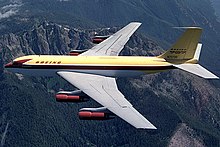

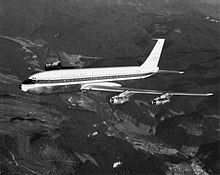



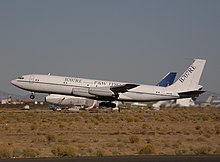
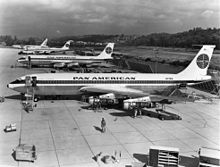

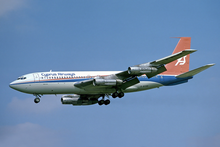


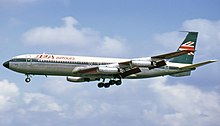
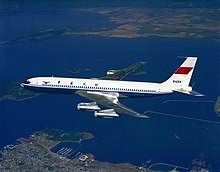
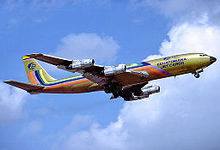

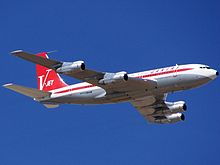


Pan AmNarrow-body airlinerManufacturerBoeing Commercial AirplanesTrans World Airlines American AirlinesAir FranceBoeing 367-80Boeing 720Boeing C-137 StratolinerBoeing E-3 SentryBoeing E-6 MercuryNorthrop Grumman E-8 Joint STARSjetlinerswept wingquadjetpodded enginesJet Ageair-transportdomestictranscontinentaltransatlantic flights7x7 seriesPratt & Whitney JT3CPratt & Whitney JT4ARolls-Royce ConwayPratt & Whitney JT3Dnautical milesE-3 SentryC-137 Stratoliner367-80Pan Am Flight 292B-17 Flying FortressB-29 SuperfortressB-47 StratojetB-52 StratofortressDouglas AircraftLockheed377 StratocruiserAerial refuelingKC-97 StratofreightersturbojetprototypeUnited States Air ForceKC-135 StratotankerLake WashingtonSeattleTex Johnstonbarrel rollBill AllenPan Am Flight 214Joseph John "Tym" TymczyszynIven C. Kincheloe AwardKrueger flapde Havilland CometQantasBraniff International AirwaysPratt & Whitney JT4ConwayturbofanDutch rollyaw damperDouglas DC-7Lockheed Constellationcrash-landedArlington, Washingtontest pilottail finthrust reversersturbocompressorscabin pressurizationMojave AirportJT8D-219US Air Force'sE-8 Joint STARSCFM International CFM56fatal accidentsNational AirportPresident EisenhowerJuan TrippeBaltimore's Friendship International AirportIdlewild AirportLe BourgetGander, NewfoundlandNational AirlinesNew York/IdlewildHoward HughesNew York-Idlewild International AirportSan Francisco International AirportContinental AirlinesUnitedEasternair traffic controlwide-bodyBoeing 7471973 oil crisisSaha Airlineshush kitTracor, IncTrans World AirlinesMiddle East AirlinesLebanonIranian Air ForceBoeing's "customer number"maximum takeoff weightwater injectionhot and highBEA AirtoursLufthansaAir Registration BoardAir-IndiaconvertibleJoe SutterE-6 MercuryAir Force Oneairborne warning and control systemPresident of the United StatesMuseum of FlightSAM 26000National Museum of the United States Air ForceDayton, OhioSAM 27000Ronald Reagan Presidential LibrarySimi Valley, CaliforniaCanadian ForcesCC-137 Husky